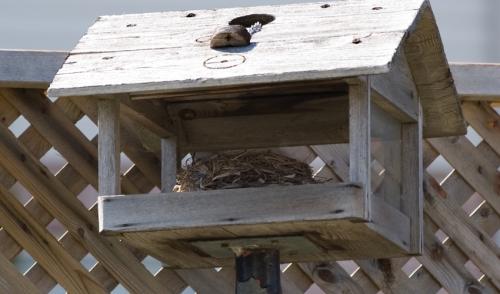
There are many different styles and sizes of bird feeders, but are they all great for every bird? If you really want to build a feeder your backyard birds will love, you need to take the birds' needs and preferences into account when designing the feeder.
Remember Birds' Needs
The most important thing to remember when building a bird feeder is that it has to be bird-friendly. Different birds prefer different foods and have different feeding styles, and meeting their needs will help ensure any feeder you build is a popular and useful one.
To build a feeder your birds will flock to, consider…
- Bird Size: The feeder should be spacious enough to comfortably accommodate the bird, without bruising its wings or making it difficult to balance on a ledge or perch. Err on the side of a too-large feeder rather than a too-small one to be sure birds have enough room to eat easily, but remember that flocks of bully birds like starlings and grackles are also comfortable at very big feeders.
- Flock Size: Some birds, such as chickadees, nuthatches and woodpeckers, typically feed alone or in pairs, while other birds, such as finches and sparrows, feed in larger flocks. The feeder should have enough feeding ports or accessibility to accommodate the right number of birds it is designed to feed.
- Feeding Style: Some birds prefer to cling to mesh and pick out tiny seeds as they feed, while others may scratch at the surface to uncover their preferred morsels. Still other birds may need space to whack away at seed hulls or nut shells. Design the feeder to suit the bird's preferred feeding style so they feel comfortable visiting for meals.
- Food Type: Birds eat many different things, and not all bird foods can be placed in all feeders. Smaller seeds such as Nyjer and millet require finer mesh and secure bases, while larger seeds such as sunflower, safflower and cracked corn need larger openings for birds to feed. Fruit and suet can be placed in trays or larger cages, and nuts can also go in trays or very large mesh feeders.
Remembering Your Needs
Birds may not be too picky about the type of feeder you build so long as it meets their needs, but in order for a feeder to be useful, it should also meet your needs as a backyard birder.
When building a feeder to meet your birding needs, consider…
- Mounting: Will the feeder be hung from a hook or tree branch? Will it attach to a post, wall or fence? Will is sit on the ground or be balanced on top of a pole? Whichever you choose, be sure it will be secure and sturdy to withstand the wind and hungry birds' attention. Also be sure you can take it down easily for cleaning and refilling.
- Refilling: Feeders with clear or open sides that allow you to see the seed level are often preferred, and the top of the feeder should be easily removable so it can be refilled quickly and conveniently. If seed will be poured into the feeder, be sure the opening is large enough for easy refilling.
- Capacity: Small feeders can be a delight in the backyard, but they also need more frequent refills. A larger feeder can hold more seed and will generally accommodate more birds, but take into account the weight of the full feeder to be sure it won't break any hooks or branches, and it is easy to handle.
- Cleaning: Thorough, regular cleaning is essential to keep a feeder in good condition and to minimize the risk of spreading diseases to backyard birds. Any feeder you build should be able to be easily cleaned and scrubbed as needed, so be sure it can come apart in ways that will allow good cleaning and sanitizing.
No matter what type of feeder you design and build, as long as you keep both the birds' needs and your own needs in mind, it can be a fabulous and welcome addition to your backyard buffet.

Comments